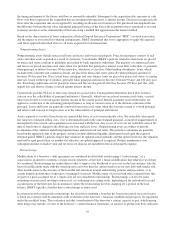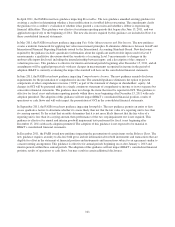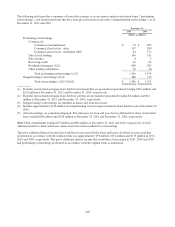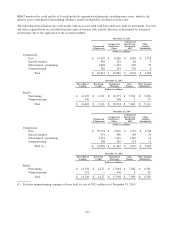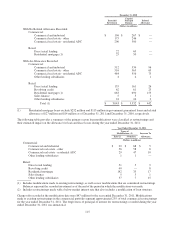BB&T 2011 Annual Report Download - page 105
Download and view the complete annual report
Please find page 105 of the 2011 BB&T annual report below. You can navigate through the pages in the report by either clicking on the pages listed below, or by using the keyword search tool below to find specific information within the annual report.
BB&T conducts periodic reviews to identify and evaluate each investment that has an unrealized loss for other-than-
temporary impairment. An unrealized loss exists when the current fair value of an individual security is less than its
amortized cost basis. Unrealized losses that are determined to be temporary in nature are recorded, net of tax, in
accumulated other comprehensive income for available-for-sale securities.
Factors considered in determining whether a loss is temporary include:
• The financial condition and near-term prospects of the issuer, including any specific events that may influence
the operations of the issuer;
• BB&T’s intent to sell and whether it is more likely than not that the Company will be required to sell these debt
securities before the anticipated recovery of the amortized cost basis;
• The length of time and the extent to which the market value has been less than cost;
• Whether the decline in fair value is attributable to specific conditions, such as conditions in an industry or in a
geographic area;
• Whether a debt security has been downgraded by a rating agency;
• Whether the financial condition of the issuer has deteriorated;
• The seniority of the security;
• Whether dividends have been reduced or eliminated, or scheduled interest payments on debt securities have not
been made; and
• Any other relevant available information.
If an unrealized loss is considered other-than-temporary, the credit component of the unrealized loss is recognized in earnings
and the non-credit component is recognized in accumulated other comprehensive income, to the extent that BB&T does not
intend to sell the security and it is more likely than not that BB&T will not be required to sell the security prior to recovery.
BB&T evaluates credit impairment related to mortgage-backed securities through the use of cash flow modeling. These models
give consideration to long-term macroeconomic factors applied to current security default rates, prepayment rates and recovery
rates and security-level performance. During 2011, OTTI recognition was due primarily to trends in the underlying loan
delinquencies and related collateral home price indices.
During 2011, BB&T realized principal losses on certain other-than-temporarily impaired securities. These realized losses
were a factor in evaluating the level of OTTI necessary to address future projected losses.
At December 31, 2011, BB&T held certain investment securities having continuous unrealized loss positions for more than 12
months. The vast majority of these losses were in non-agency mortgage-backed and municipal securities. At December 31,
2011, all of the available-for-sale debt securities in an unrealized loss position for more than 12 months, excluding those covered
by FDIC loss sharing agreements, were investment grade with the exception of two municipal bonds with an amortized cost of
$8 million and ten non-agency mortgage-backed securities with an adjusted amortized cost of $423 million.
All of the non-investment grade securities referenced above were initially investment grade and have been downgraded since
purchase. Based on its evaluation at December 31, 2011, BB&T determined that certain of the non-investment grade
non-agency mortgage-backed securities had credit losses evident and recognized OTTI related to these securities. At
December 31, 2011, the total unrealized loss on these non-investment grade securities was $55 million.
The following table presents non-investment grade securities with significant unrealized losses that are not covered by a
loss sharing arrangement and the credit loss component of OTTI recognized to date:
December 31, 2011
Amortized
Cost
Cumulative
Credit Loss
Recognized
Adjusted
Amortized Cost
Fair
Value
Unrealized
Loss
(Dollars in millions)
Security:
RMBS 1 $ 133 $ (34) $ 99 $ 88 $ (11)
RMBS 2 102 (16) 86 73 (13)
105


